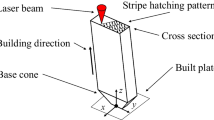Abstract
In cold spraying, bonding is associated with shear instabilities caused by high strain rate deformation during the impact. It is well known that bonding occurs when the impact velocity of an impacting particle exceeds a critical value. This critical velocity depends not only on the type of spray material, but also on the powder quality, the particle size, and the particle impact temperature. Up to now, optimization of cold spraying mainly focused on increasing the particle velocity. The new approach presented in this contribution demonstrates capabilities to reduce critical velocities by well-tuned powder sizes and particle impact temperatures. A newly designed temperature control unit was implemented to a conventional cold spray system and various spray experiments with different powder size cuts were performed to verify results from calculations. Microstructures and mechanical strength of coatings demonstrate that the coating quality can be significantly improved by using well-tuned powder sizes and higher process gas temperatures. The presented optimization strategy, using copper as an example, can be transferred to a variety of spray materials and thus, should boost the development of the cold spray technology with respect to the coating quality.
Similar content being viewed by others
References
T. Stoltenhoff, H. Kreye, and H.J. Richter, An Analysis of the Cold Spray Process and Its Coatings,J. Therm. Spray Technol., 2002,11, p 542–550
J. Voyer, T. Stoltenhoff, and H. Kreye, Development of Cold Sprayed Coatings,Proc. ITSC 2003 (Orlando), B.R. Marple, C. Moreau, Ed., ASM International, 2003, p 71–78
T. van Steenkiste and J.R. Smith, Evaluation of Coating Produced via Kinetic and Cold Spray Processes,J. Therm. Spray Technol., 2004,13, p 274–282
H. Assadi, F. Gärtner, T. Stoltenhoff, and H. Kreye, Bonding Mechanism in Cold Gas Spraying,Acta Mater., 2003,51, p 4379–4394
T. Schmidt, F. Gärtner, H. Assadi, and H. Kreye, Development of a Generalized Parameter Window for Cold Spray Deposition,Acta Mater., 2006,54, p 729–742
A.N. Papyrin, S.V. Klinkow, and V.F. Kosarev:Modelling of Particle-Substrate Adhesive Interaction under the Cold Spray Process,Op. Cit. ref. 2, p 27–35
Materials properties data base: www.matweb.com
“Standard Test Method for Adhesion or Cohesion Strength of Thermal Spray Coatings,” C 633,Annual Book of ASTM Standards, ASTM
F. Gärtner, T. Stoltenhoff, J. Voyer, and H. Kreye, Mechanical Properties of Cold Sprayed and Thermally Sprayed Copper Coatings,Surf. Coat. Technol., 2006,200, 6770–6782
Product Information for High Purity Copper (99.99 %): Wieland Werke, Ulm, Germany
Author information
Authors and Affiliations
Corresponding author
Additional information
This article was originally published inBuilding on 100 Years of Success, Proceedings of the 2006 International Thermal Spray Conference (Seattle, WA), May 15–18, 2006, B.R. Marple, M.M. Hyland, Y.-Ch. Lau, R.S. Lima, and J. Voyer, Ed., ASM International, Materials Park, OH, 2006.
Rights and permissions
About this article
Cite this article
Schmidt, T., Gaertner, F. & Kreye, H. New developments in cold spray based on higher gas and particle temperatures. J Therm Spray Tech 15, 488–494 (2006). https://doi.org/10.1361/105996306X147144
Received:
Revised:
Issue Date:
DOI: https://doi.org/10.1361/105996306X147144




